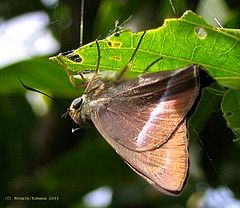
List of butterflies of India (Hesperiidae)
Encyclopedia

India
India , officially the Republic of India , is a country in South Asia. It is the seventh-largest country by geographical area, the second-most populous country with over 1.2 billion people, and the most populous democracy in the world...
has a rich biodiversity of butterflies
Butterfly
A butterfly is a mainly day-flying insect of the order Lepidoptera, which includes the butterflies and moths. Like other holometabolous insects, the butterfly's life cycle consists of four parts: egg, larva, pupa and adult. Most species are diurnal. Butterflies have large, often brightly coloured...
, of which skippers
Skipper (butterfly)
A skipper or skipper butterfly is a butterfly of the family Hesperiidae. They are named after their quick, darting flight habits. There are more than 3500 recognized species of skippers and they occur worldwide, but with the greatest diversity in the Neotropical regions of Central and South...
are a well represented family. Of the seven subfamilies belonging to the family Hesperiidae, four are found in India, comprising a total of 223 species of 74 genera and these are listed below.
General characteristics
Hesperids are often difficult to identify to species level in the field and accurate identification may require dissectionDissection
Dissection is usually the process of disassembling and observing something to determine its internal structure and as an aid to discerning the functions and relationships of its components....
and examination of the genitalia. The larval food plants are mainly grass
Grass
Grasses, or more technically graminoids, are monocotyledonous, usually herbaceous plants with narrow leaves growing from the base. They include the "true grasses", of the Poaceae family, as well as the sedges and the rushes . The true grasses include cereals, bamboo and the grasses of lawns ...
es, palm
Arecaceae
Arecaceae or Palmae , are a family of flowering plants, the only family in the monocot order Arecales. There are roughly 202 currently known genera with around 2600 species, most of which are restricted to tropical, subtropical, and warm temperate climates...
s and bamboo
Bamboo
Bamboo is a group of perennial evergreens in the true grass family Poaceae, subfamily Bambusoideae, tribe Bambuseae. Giant bamboos are the largest members of the grass family....
s. Some feed on dicotyledon
Dicotyledon
The dicotyledons, also known as dicots, are a group of flowering plants whose seed typically has two embryonic leaves or cotyledons. There are around 199,350 species within this group...
species. Egg
Egg (biology)
An egg is an organic vessel in which an embryo first begins to develop. In most birds, reptiles, insects, molluscs, fish, and monotremes, an egg is the zygote, resulting from fertilization of the ovum, which is expelled from the body and permitted to develop outside the body until the developing...
s are smooth, or sometimes ridged and white or red in color. Larva
Larva
A larva is a distinct juvenile form many animals undergo before metamorphosis into adults. Animals with indirect development such as insects, amphibians, or cnidarians typically have a larval phase of their life cycle...
e are cylindrical with a large head. They are usually green or transparent green and sometimes conspicuously marked. The larvae feed within cells made out of rolled leaves and pupation occurs inside the cell. The pupa is generally covered with fine white powder.
Subfamily CoeliadinaeCoeliadinaeCoeliadinae is a subfamily of the skipper butterfly family . With about 150 described species, this is one of several smallish skipper butterfly subfamilies. It was first proposed by William Frederick Evans in 1937....
See List of butterflies of India (Coeliadinae) (20 species, four genera).Subfamily Hesperiinae
See List of butterflies of India (Hesperiinae) (133 species, 48 genera).Subfamily Pyrginae
See List of butterflies of India (Pyrginae) (69 species, 21 genera).Subfamily Heteropterinae
- Apostictopterus fuliginosus LeechJohn Henry LeechJohn Henry Leech John Henry Leech John Henry Leech (5 December 1862- 29 December 1900, Salisbury was an English entomologist who specialised in Lepidoptera and Coleoptera.His collections from China , Japan and Kashmir are in the Natural History Museum , London.These contain also insects from...
, 1893
See also
- Hesperiidae.
- List of butterflies of India.
- Fauna of India.

